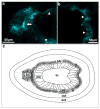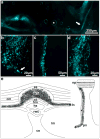The catecholaminergic nerve plexus of Holothuroidea
- PMID: 20827375
- PMCID: PMC2934915
- DOI: 10.1007/s00435-010-0103-y
The catecholaminergic nerve plexus of Holothuroidea
Abstract
Catecholamines have been extensively reported to be present in most animal groups, including members of Echinodermata. In this study, we investigated the presence and distribution of catecholaminergic nerves in two members of the Holothuroidea, Holothuria glaberrima (Selenka, 1867) (Aspidochirotida, Holothuroidea) and Holothuria mexicana (Ludwig, 1875) (Aspidochirotida, Holothuroidea), by using induced fluorescence for catecholamines on tissue sections and immunohistochemistry with an antibody that recognizes tyrosine hydroxylase. The presence of a catecholaminergic nerve plexus similar in distribution and extension to those previously reported in other members of Echinodermata was observed. This plexus, composed of cells and fibers, is found in the ectoneural component of the echinoderm nervous system and is continuous with the circumoral nerve ring and the radial nerves, tentacular nerves, and esophageal plexus. In addition, fluorescent nerves in the tube feet are continuous with the catecholaminergic components of the radial nerve cords. This is the first comprehensive report on the presence and distribution of catecholamines in the nervous system of Holothuroidea. The continuity and distribution of the catecholaminergic plexus strengthen the notion that the catecholaminergic cells are interneurons, since these do not form part of the known sensory or motor circuits and the fluorescence is confined to organized nervous tissue.
Figures






References
-
- Bishop CD, Burke RD. Ontogeny of the holothurian larval nervous system: evolution of larval forms. Dev Genes Evol. 2007;217(8):585–592. - PubMed
-
- Bouland C, Massin C, Jangoux M. The fine structure of the buccal tentacles of Holothuria forskali (Echinodermata, Holothuroidea) Zoomorphology. 1982;101:133–149.
-
- Bradford HF. Chemical neurobiology: an introduction to neurochemistry. Freeman; New York: 1986.
-
- Buznikov GA, Peterson RE, Nikitina LA, Bezuglov VV, Lauder JM. The pre-nervous serotonergic system of developing sea urchin embryos and larvae: pharmacologic and immunocytochemical evidence. Neurochem Res. 2005;30(6–7):825–837. - PubMed
-
- Cobb JLS. The distribution of mono-amines in the nervous system of echinoderms. Comp Biochem Physiol. 1969a;28:967–971.
Grants and funding
LinkOut - more resources
Full Text Sources
Miscellaneous
